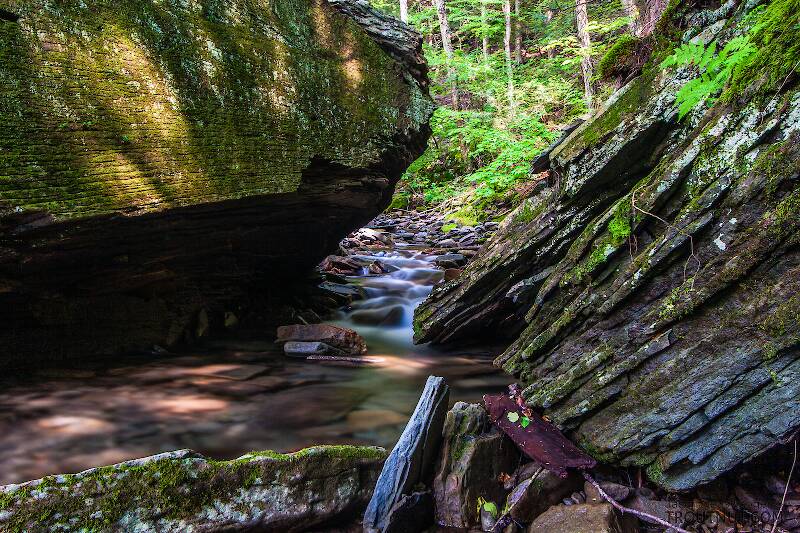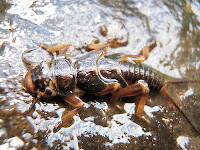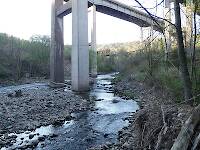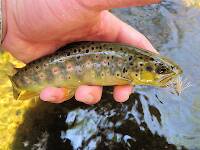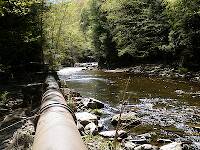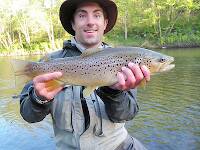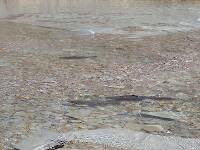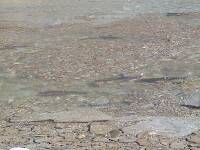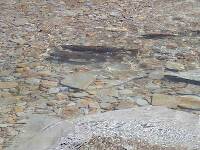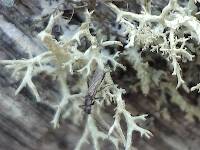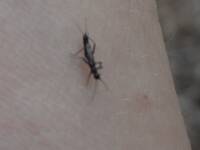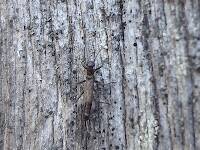
Blue-winged Olives
Baetis
Tiny Baetis mayflies are perhaps the most commonly encountered and imitated by anglers on all American trout streams due to their great abundance, widespread distribution, and trout-friendly emergence habits.
Featured on the forum

Troutnut is a project started in 2003 by salmonid ecologist Jason "Troutnut" Neuswanger to help anglers and
fly tyers unabashedly embrace the entomological side of the sport. Learn more about Troutnut or
support the project for an enhanced experience here.
Shawnny3 on Sep 3, 2008September 3rd, 2008, 12:20 pm EDT
On another thread, a brief discussion took place regarding how to improve a marginal trout stream's bed to better the trout population and fishing. I thought it might be worthy of a thread of its own.
First, does anyone have any philosophical misgivings regarding the manipulation of a streambed? Mother nature messes with stream topography all the time (and, on a geological time scale, will undo whatever alterations people make anyway), but should humans just leave streams in the condition they've found them, or is it OK to tinker with them?
Second, what strategies would people recommend for effectively manipulating streams? Personally, I'm most interested in strategies that allow the stream to retain a certain natural look and feel, but I don't want to focus the discussion to my own bents - all thoughts and ideas welcome.
Thanks,
Shawn
First, does anyone have any philosophical misgivings regarding the manipulation of a streambed? Mother nature messes with stream topography all the time (and, on a geological time scale, will undo whatever alterations people make anyway), but should humans just leave streams in the condition they've found them, or is it OK to tinker with them?
Second, what strategies would people recommend for effectively manipulating streams? Personally, I'm most interested in strategies that allow the stream to retain a certain natural look and feel, but I don't want to focus the discussion to my own bents - all thoughts and ideas welcome.
Thanks,
Shawn
Jewelry-Quality Artistic Salmon Flies, by Shawn Davis
www.davisflydesigns.com
www.davisflydesigns.com
Martinlf on Sep 3, 2008September 3rd, 2008, 2:53 pm EDT
Shawn, folks do this all the time--kids build dams, etc. A fish commission officer did tell me once that one should have a permit for such work, so I'd advise taking care with this project, and keeping it on the Q.T. to some degree. I wish more work were done on brook trout streams, myself, but it may be that someone would need to study the methods a good bit before starting in.
"He spread them a yard and a half. 'And every one that got away is this big.'"
--Fred Chappell
--Fred Chappell
Trtklr on Sep 4, 2008September 4th, 2008, 1:14 pm EDT
great question. I offered to help with two different streams in michigan this year and neither party returned my e-mail. I can see some ways they improve streams but I am very interested in what is done. I cant tell you how many times i looked at stream and thought this would be a great place for a fallen tree, but I don't want to screw a stream up and I'm pretty sure its illegal. so I would be interested in what kinds of improvements are usually done. like I said I've seen j hooks and logs set to divert water, the piling up of rocks on banks for erosion control. the little manistee had logs that were placed by banks at an angle the only problem I see with that is now the logs have eroded and sometimes I come across metal spikes by these logs, not too attractive.
I have seen nothing more beautiful than the sunrise on a cold stream.
Aaron7_8 on Sep 5, 2008September 5th, 2008, 1:35 pm EDT
I have noticed in MT that they do almost all river inprovements on the basis of erosion control. By adding rip rap to eroding banks and planting grass and other flora to burned/deforested hillsides. I have also been told to not walk in the stream bed as it destroys much of the aquatic insect habitat.
Troutnut on Sep 6, 2008September 6th, 2008, 9:54 am EDT
First, does anyone have any philosophical misgivings regarding the manipulation of a streambed? Mother nature messes with stream topography all the time (and, on a geological time scale, will undo whatever alterations people make anyway), but should humans just leave streams in the condition they've found them, or is it OK to tinker with them?
In most parts of the lower 48, there's no such thing as a stream in the condition we found it. Even seemingly pristine wild rivers often show major effects of 100-year-old logging on their stream beds and riparian vegetation. Add in man-made global warming, depletion of ground water in wells, acid rain, non-native species, erosion, and everything else we've done to these rivers, and there's a good case to be made that most habitat improvements are restoration more than modification.
Second, what strategies would people recommend for effectively manipulating streams? Personally, I'm most interested in strategies that allow the stream to retain a certain natural look and feel, but I don't want to focus the discussion to my own bents - all thoughts and ideas welcome.
Planting trees to stabilize unnaturally eroding banks, adding strategically positioned wood and rocks, and improving shade and groundwater flow.
Here's a good example of a restoration project my dad recently supervised for the WI DNR on the upper Namekagon. There's a beautiful little spring that turns it from a warm-water lake outlet into a trout stream. For the last several decades, all the water from that spring was flowing through a series of shallow, silted-in artificial trout ponds created ages ago for a private hatchery or something. It was warming up quite a bit before hitting the river. The DNR went in and renovated it to cut the ponds out of the system and deliver most of that cool spring water directly into the river.
Jason Neuswanger, Ph.D.
Troutnut and salmonid ecologist
Troutnut and salmonid ecologist
HighFlyer on Sep 9, 2008September 9th, 2008, 2:59 am EDT
I would love to become part of an effort here in Minnesota to do this.
I did note that one poster in this thread said that you shouldn't walk down the middle of the streams. Duly noted and I will stop doing that immediately.
I've been planning on looking into this over the winter here, so that next spring I can be a part of something like this.
And I completely agree with the poster (Toutnut, I believe) who said that in todays day and age, it's really more stream restoration than modification. We've done enough damage to nature over he course of time... I think it's alright to now give it a helping hand too.
I did note that one poster in this thread said that you shouldn't walk down the middle of the streams. Duly noted and I will stop doing that immediately.
I've been planning on looking into this over the winter here, so that next spring I can be a part of something like this.
And I completely agree with the poster (Toutnut, I believe) who said that in todays day and age, it's really more stream restoration than modification. We've done enough damage to nature over he course of time... I think it's alright to now give it a helping hand too.
"Calling Fly Fishing a hobby is like calling Brain Surgery a job."
~by Paul Schullery~
"Many men go fishing all of their lives without knowing that it is not fish they are after."
~by Henry David Thoreau~
~by Paul Schullery~
"Many men go fishing all of their lives without knowing that it is not fish they are after."
~by Henry David Thoreau~
RleeP on Sep 9, 2008September 9th, 2008, 4:45 am EDT
>>Mother nature messes with stream topography all the time (and, on a geological time scale, will undo whatever alterations people make anyway)>>
Exactly.. And often, the time frame we are talking about is better measured by Eastern Standard Time than geological time.
I have no philosophical problem with stream restoration/improvement/manipulation in order to improve trout habitat and spawning success, mostly because these days, such efforts are usually corrective rather than original or primary. In most cases, had the stream and its habitat not been messed with by the myriad of things we do as the alleged superior species on the planet, the restorative effort would not be necessary. And as a wise man once told me regarding a completely unrelated matter: "If it were not necessary, it would not be needed!!"
It's hard to disagree with that...:)
I think though that is often tricky to determine whether a proposed stream improvement project, once completed, will actually do more for the fish and the fishery or for those who did the work.
On medium to higher gradient smaller streams in the mountain counties of Pennsylvania, you can see the remnants of a pretty fair number of old CCC or TU in-stream device projects. At normal flows, many or most of them are high and dry and not at all involved in any way with directing flow or providing habitat because over the years of floods and whatnot, the stream went elsewhere plowing out its path of least resistance. These projects really did no good other than to promote fellowship between like-minded conservationists through a shared day of stream work. Nothing wrong with that, of course. Its just that it isn't at all cost effective.
On the other hand, in the 9 years we've been out here in the Midwest, I've seen the same sort of devices in streams in WI and IA withstand floods, ice scour and more. I think this has more to do with gradient and flow characteristics than quality of construction.
Some streams are best improved with these sorts of projects/devices. For others, the best you can do is protect the riparian buffer in order to anchor and stabilize the banks .
But overall, I'm very much in favor of these sorts of efforts. Arguably, in the area where I now live, they have increased the quality of the trout fishery many fold.
Exactly.. And often, the time frame we are talking about is better measured by Eastern Standard Time than geological time.
I have no philosophical problem with stream restoration/improvement/manipulation in order to improve trout habitat and spawning success, mostly because these days, such efforts are usually corrective rather than original or primary. In most cases, had the stream and its habitat not been messed with by the myriad of things we do as the alleged superior species on the planet, the restorative effort would not be necessary. And as a wise man once told me regarding a completely unrelated matter: "If it were not necessary, it would not be needed!!"
It's hard to disagree with that...:)
I think though that is often tricky to determine whether a proposed stream improvement project, once completed, will actually do more for the fish and the fishery or for those who did the work.
On medium to higher gradient smaller streams in the mountain counties of Pennsylvania, you can see the remnants of a pretty fair number of old CCC or TU in-stream device projects. At normal flows, many or most of them are high and dry and not at all involved in any way with directing flow or providing habitat because over the years of floods and whatnot, the stream went elsewhere plowing out its path of least resistance. These projects really did no good other than to promote fellowship between like-minded conservationists through a shared day of stream work. Nothing wrong with that, of course. Its just that it isn't at all cost effective.
On the other hand, in the 9 years we've been out here in the Midwest, I've seen the same sort of devices in streams in WI and IA withstand floods, ice scour and more. I think this has more to do with gradient and flow characteristics than quality of construction.
Some streams are best improved with these sorts of projects/devices. For others, the best you can do is protect the riparian buffer in order to anchor and stabilize the banks .
But overall, I'm very much in favor of these sorts of efforts. Arguably, in the area where I now live, they have increased the quality of the trout fishery many fold.
Quick Reply
Related Discussions
Topic
Replies
Last Reply
1
Sep 14, 2010
by SlateDrake9
by SlateDrake9
5
Jul 15, 2012
by Jmd123
by Jmd123

